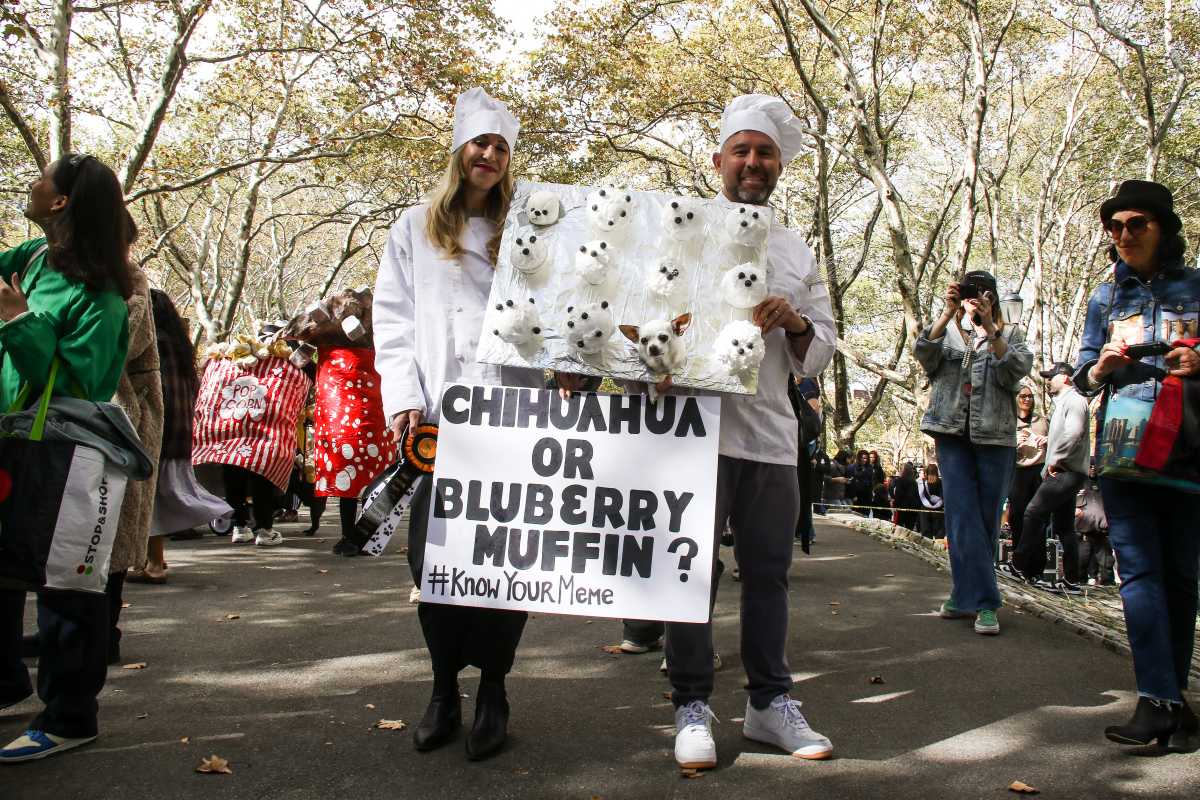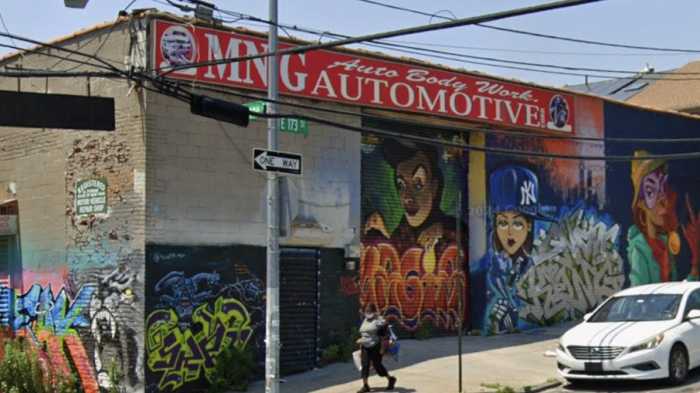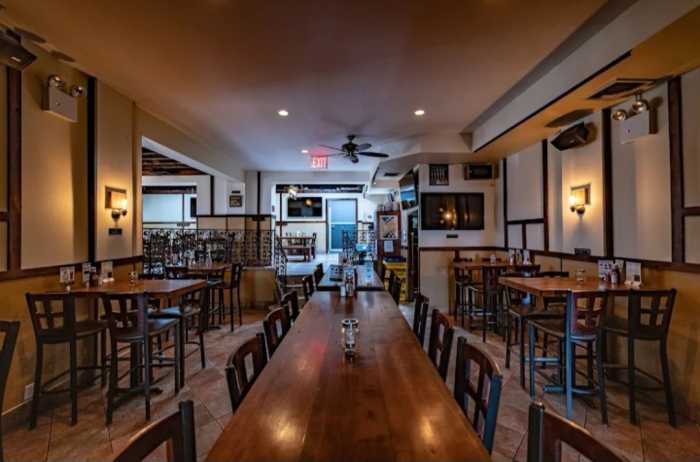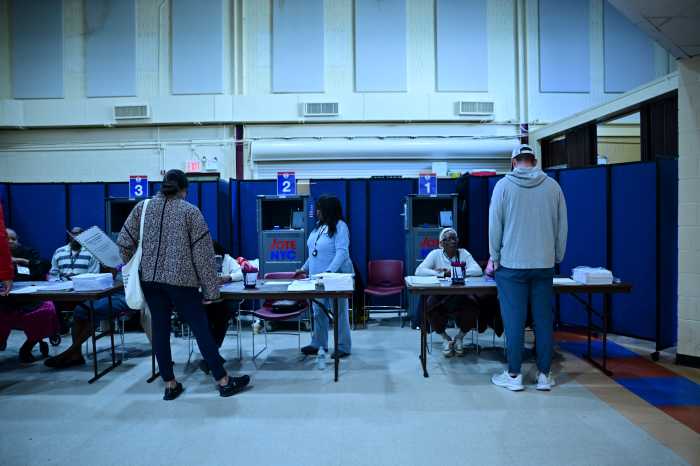
Hal Bromm in his self-named gallery in Tribeca.
BY DUSICA SUE MALESEVIC | Hal Bromm can’t stay seated.
The gallery owner was compelled to get up and show the art featured in his 40th anniversary show that was created by former and current Tribeca neighbors.
“Jody Pinto still lives on Chambers St.,” said Bromm, pointing to her 2015 watercolor “Rescue” — a swirl of dark and light browns and blue featuring what appears to be a man.
During a recent interview at Hal Bromm Gallery, he reeled off other artists featured in “40: The Anniversary Exhibition” — Keith Sonnier, Linda Francis, Jene Highstein and Suzanne Harris — that used to live on Chambers St. near his eponymous gallery at 90 W. Broadway.
His roots in Tribeca — both for art and preservation — run deep. Bromm has lived in the neighborhood since the ‘70s, before it earned the acronym of “triangle below Canal.”
A New Jersey native, Bromm first moved to Brooklyn to attend Pratt. Originally a fine art major, he shifted to environmental design, which was a program that melded architecture, art, photography, lighting theory and engineering; as well as other disciplines.
“Then I came to Tribeca in the early ‘70s,” he explained. “I was working for a big architectural firm before I started my own business and they had an office in Manhattan. And the commute from Pratt to work everyday got to be tedious. I was very lucky — found this great loft in a former cheese warehouse at Beach St.”
At his Beach St. loft, he held his first art show in 1975. Although Bromm had grown up drawing and was artistically inclined, he said, “At a certain point, I had more fun looking at other people’s work than creating my own.”
That first exhibition featured young artists living and working in London and was called “New London in New York.” Bromm pointed to a piece above him — blond wood surrounding what looks like a chalkboard etched with shapes — by Derek Jarman, a filmmaker who introduced him to the group.
Other shows were staged at his lofAt and a real estate friend told Bromm he should get a “proper space that’s just a gallery” and talked him into renting at 114 Franklin St.
Next door, was the Franklin Furnace — now in Brooklyn — founded by Martha Wilson. Bromm pointed ahead to Wilson’s 2009 “Mona/Martha/Marge” — Wilson’s face sporting a striking blue bouffant and bright pink pearl necklace superimposed on the Mona Lisa’s body.
“We became good friends,” he said. “We were both really pioneers in the Tribeca art scene. She in the nonprofit world, me in the theoretical for-profit world.”
At Franklin St., the first show was titled “Moving” and “invited artists to create works around the idea of movement, relocation,” said Bromm.
After a year at the Franklin St. building, Bromm decided to move the gallery to 90 W. Broadway in 1977. Initially, the gallery was on the top floor, but when the building turned residential it moved to the second floor, where it is now located.
In the ‘80s, the gallery also had an outpost in the East Village on Ave. A and E. 11th St.
“That was a lot of fun,” he said. “It was very different from here because it was on the street level so anybody could just walk into the door, including people who had been up for three days on crack or something.”
He added, “One time, someone came in and picked up our IBM typewriter and threw it on the floor and ran out.”
Also in the ‘80s, Bromm started thinking about the preservation of the neighborhood.
“In 1984, a bunch of us who had been here awhile became aware that the neighborhood was becoming attractive to developers who sensed that this was a neighborhood full of artists and design people and young creative types and that it had a good vibe,” he said.
It was interesting, he said, because when he first moved to Tribeca, “the neighborhood was nothing” and he had called it, in another interview, a “marvelous no man’s land.”
“There were very few of us down here and people who were pioneers got to know each other,” he said. “The rents were cheap. There was one restaurant [Delphi], which was the Greek restaurant at the corner of Reade and W. Broadway.”
If you wanted to go food shopping, he said, you had to go to the Village. He pointed out the irony, as Tribeca used to have Washington Market, an area that was also known as the Butter and Egg District.
Bromm had always loved old buildings — their character and architectural richness — and when he and the other tenants were offered a chance to buy 10 Beach St., he said it was a “no-brainer.”
“We love being here,” he said. “It’s a good building. And the people in the building were overwhelmed by that idea. I was young enough and foolish enough to be fearless and I said, ‘Come on, let’s just buy the building.’ ”
He said he borrowed money from everyone he knew, “including people who said, ‘Hal, New York’s going bankrupt; you shouldn’t be buying anything.’ Fortunately they turned out to be wrong. But, you know, they could have been right.”
The building at Beach St. was six stories and Bromm started noticing buildings in the neighborhood sprouting two- or three-story additions, cornices ripped off and, he said, “really bad, ugly stuff.”
“We got together and we started a group called the Committee for the Washington Market Historic District to preserve what was left,” he said. “Keeping in mind that blocks and blocks had been demolished at the end of the ‘60s by New York City, which was a horrible loss.”
The group went to the Landmarks Preservation Commission around the mid-1980s to request that it evaluate the entire neighborhood as a potential historic district, he said. They asked Andrew Dolkart, an architectural historian, to figure out what the boundaries of this potential district should be, said Bromm.
Underfunded and understaffed, the commission was already considering the neighborhood and enlisted the group’s help for research and photography, said Bromm.
Out of their work — Dolkart, Oliver Allen, Carole DeSaram and others — a book called “The Texture of Tribeca” was published in 1989. It turned out to be a beautiful book, said Bromm, and it was an important lobbying and educational tool.
In the early ‘90s, Tribeca got four small historic districts designated instead of one big one, said Bromm.
“It’s affected [Tribeca] badly because we have things like 56 Leonard,” said Bromm. “A building that might have been not out of place in Lower Manhattan or on the Upper East Side…but that building in Tribeca is grossly inappropriate. Right on the edge of one of the historic districts towering over everything.
“And it’s a ‘look-at-me’ building,” he continued. “It’s a look at me, I’m rich, I’m trendy, I’m buying this glamorous over-the-top condo because I want to be in trendy Tribeca. But it’s nothing to do with Tribeca. It’s nothing to do with the old Washington Market. It’s a denigration of what the districts are meant to convey.”
After the designation of the four districts, Bromm helped start a new group called Committee for the Expansion of Historic Districts, which has had meager success, he said. But the Tribeca Trust, he said, has taken up the mantle.
Lynn Ellsworth, chairperson of the Tribeca Trust, said Bromm and DeSaram provided leadership to get the neighborhood’s designated districts and “stepped up to the plate to do all the work that it takes to make something like this happen.”
“Hal is a hero,” she said in a phone interview. “In my world that’s heroic civic engagement and Hal did it.”
Bromm is an advisor for the Trust, and Ellsworth said he and DeSaram have been kind, helpful and unstinting with providing advice and guidance.
Roger Byrom, chairperson of Community Board 1’s Landmarks Committee, said he has known Bromm since the early ‘90s and praised his “tremendous contribution” to the neighborhood — both for art and preservation.
“He took the time, trouble and initiative to spearhead the first effort [for designation],” Byrom said in a phone interview.
Bromm still lives in Tribeca and after looking around his gallery, he realized the preponderance of artists that do or did live in the neighborhood — like Marja Samsom. Her 2015 “Endless Egg” — a close-up of an egg oozing its yolk and screaming for a piece of bread — greets visitors in the gallery’s doorway.
For Bromm, who declined to give his age, it is hard to believe that his gallery is celebrating its 40th year.
“What’s that old expression, time flies when you’re having fun,” he said. “It sounds kind of corny but, you know, 40 years is a helluva long time, it simply doesn’t feel like 40 years.”







































